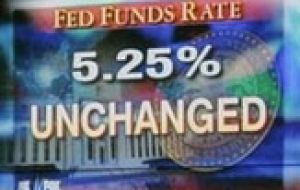MercoPress. South Atlantic News Agency
Fed concerned about growth and inflation

Federal Reserve Chairman Ben Bernanke and his colleagues are still worried about inflation, even while hinting that an interest rate cut may be needed to help boost a weak economy.
That suggestion of a change in thinking on interest rates was contained Wednesday in the Fed's latest statement on the economy. Although the Fed made just a slight change in wording from previous statements, it was enough to trigger celebrations on Wall Street. Investors pushed stocks higher on the belief that the central bank was getting ready to rescue the faltering economy by cutting interest rates. Private economists, however, weren't so definite in their own reading of the Fed's message. Many saw the wording change as, at best, a small baby step toward considering rate cuts. But they said any actual reduction was still months away. The Fed tweaked its policy statement on Wednesday, but it did not change interest rates. For the sixth consecutive meeting, the central bank left its key policy tool, the federal funds rate, unchanged at 5.25 percent. It has been at that level since June 2006 when the central bank capped a two-year campaign to tighten interest rates with a 17th quarter-point move. The decision Wednesday means that banks' prime lending rate, the benchmark for millions of consumer and business loans, will remain unchanged at 8.25 percent. While the Fed has not changed interest rates in nine months, it has continually signaled during that time that it stood ready to raise rates if inflation pressures did not subside. But in the statement Wednesday, the Fed dropped the wording about possible "additional firming," the Fed's code for rate increases. Instead, it talked about "future policy adjustments," a phrase that could be interpreted as either rate hikes or rate cuts. And it said those adjustments will depend on the "outlook for both inflation and economic growth" in the months ahead. That was enough to cause a big rally on Wall Street, where investors are eager to see rate cuts as a way to ease concerns that the country could slip into a recession this year. Concerns about a downturn, heightened by comments from former Fed Chairman Alan Greenspan and growing troubles among mortgage lenders, helped trigger a 416-point drop in the Dow Jones industrial average on Feb. 27. The Fed did not cite the market turbulence in its statement, but it did note that recent economic indicators have been "mixed," a downgrade from the Fed's view at the January meeting that recent indicators showed "somewhat firmer economic growth." It also said the correction in the once high-flying housing market was still "on-going" while in January Fed officials had detected "tentative signs of stabilization" in housing. In the new statement, the Fed also showed greater concerns about inflation, noting that readings on core inflation, which excludes energy and food, had been "somewhat elevated" recently, a comment that reflected the bigger-than-expected increases in consumer and wholesale inflation reported last week. The Fed continued to stress that its "predominant policy concern" remained the risk that inflation will not moderate as expected as the economy slows. Analysts said economic developments have left the Fed trapped between the opposing forces of a weakening economy and rising inflation. "The Fed is caught right now. The inflation numbers are looking worse, but on the other hand, the economy is looking softer," said David Wyss, chief economist at Standard & Poor's in New York. Wyss said he believed the Fed was using the statement to edge closer to cutting rates if necessary to bolster economic growth, but he said investors should not expect any change at the Fed's next meeting on May 9. David Jones, chief economist at DMJ Advisors, a private consulting firm, said he believed the Fed would remain on hold probably until September. "The Fed is facing a standoff. The economy is slowing and inflation is getting worse," Jones said. "They have got to let the dust settle on this very mixed picture before they do anything." Wyss said the Fed could cut rates as many as three times although he said some of those reductions might not come until next year. Jones said he believed the Fed might be content to just cut rates once in the second half of this year if the economy is showing signs of rebounding at that time.




Top Comments
Disclaimer & comment rulesCommenting for this story is now closed.
If you have a Facebook account, become a fan and comment on our Facebook Page!